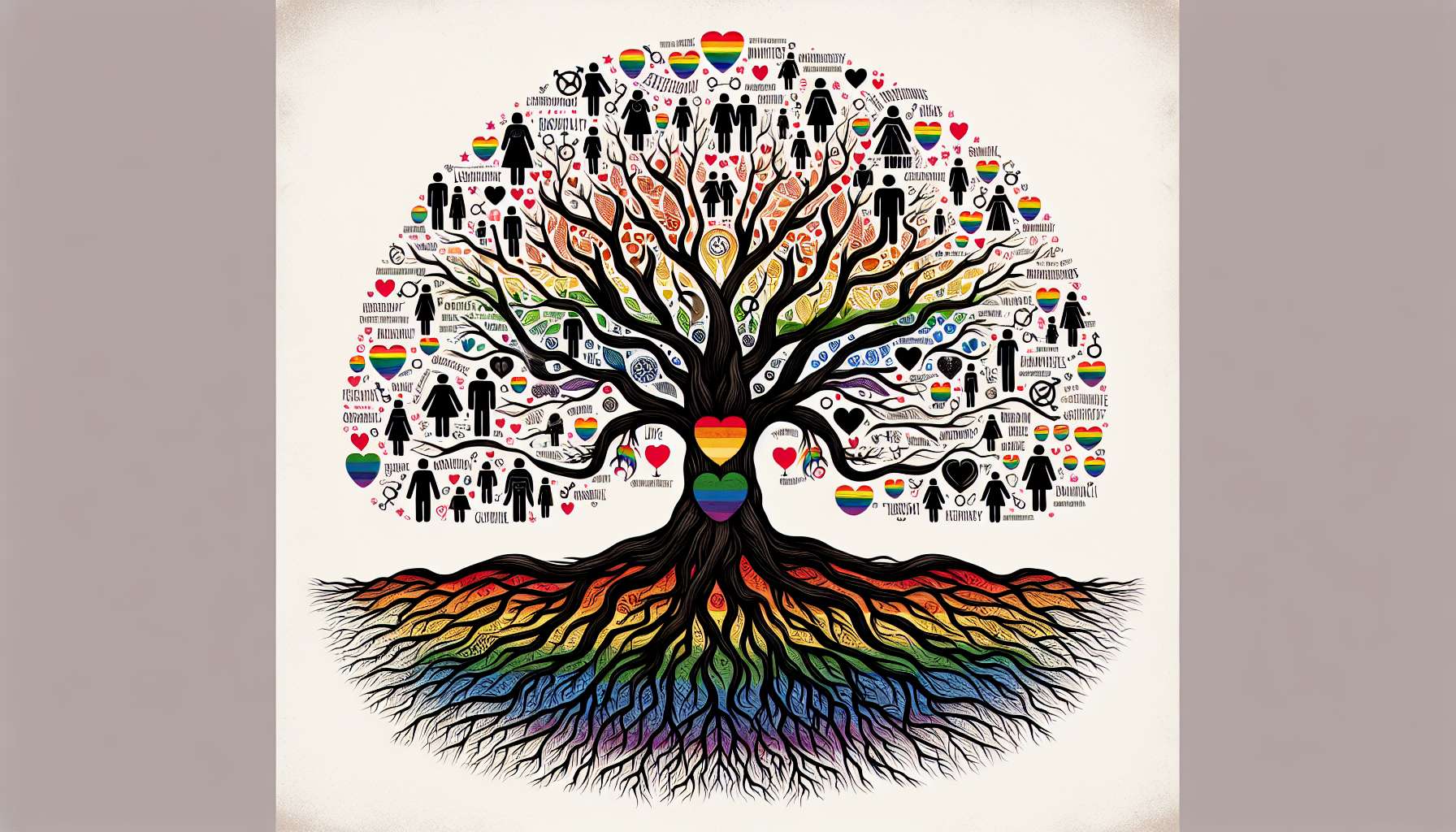Systemic and family approaches provide essential insight for understanding and assisting LGBTQ+ people within their relational environment. They focus on how family interactions and dynamics influence the construction of identity and the wellbeing of individuals.
A central concept of systemic approaches is that of the family system. The family is seen as a complex system, consisting of interacting subsystems (conjugal, parental, sibling). Each family member has a defined place and role, all within relational rules and patterns. For LGBTQ+ people, the family system can be a source of support and acceptance, but also of conflict and rejection. The coming-out of a member often disrupts the system’s balance and necessitates a reorganization of relationships.
Systemic approaches consider the family loyalties, i.e., the bonds of belonging and solidarity that unite family members. These loyalties can conflict with the assertion of an LGBTQ+ identity and be perceived as a betrayal or threat to family cohesion. The therapeutic work will aim to help the person reconcile their various loyalties, finding a balance between their need for individualism and their belonging to the family system.
The notion of family myth is also relevant. Myths are shared beliefs that give meaning to the history and identity of the family. They can be explicit or implicit, conscious or unconscious. For families of LGBTQ+ people, the myth of heterosexuality and cisgender identity is often central. The emergence of an LGBTQ+ identity questions this myth and can trigger resistances. The therapist will help the family deconstruct invalidating myths and develop new, more inclusive and supportive ones.
Thus, in assisting a young lesbian woman in conflict with her family, the systematic therapist will explore the loyalties and myths at work. They may shed light on how the young woman’s coming-out disrupts the myth of a “normal and traditional” family. They will support the family in crafting a new narrative in which the diversity of sexual orientations is accepted and valued. Alongside this, they will support the young woman in her individuation process, aiding her in the assertion of her needs and boundaries regarding her family.
Systemic approaches attach great importance to communication within the family. They analyze patterns of verbal and non-verbal communication, noting explicit and implicit messages that circulate. For families of LGBTQ+ people, communication surrounding sexual orientation or gender identity is often emotionally charged. There may be unspoken aspects, double messages, or paradoxical injunctions (for instance, “be yourself, but don’t shame us”). The therapist will assist the family in developing clearer, more authentic communication, promoting each person’s expression of feelings and needs.
Another key concept is that of boundaries. Boundaries refer to what separates and connects the different family subsystems. They can be rigid (little exchange, strong differentiation), clear (balance between belonging and individuation), or blurred (intermingling, lack of differentiation). For LGBTQ+ individuals, boundaries may be undermined by reactions to coming-out in their environment. A rigid boundary may emerge, excluding the LGBTQ+ person from certain family spaces. Conversely, blurred boundaries can lead relatives to intrusively intervene in the person’s intimate life. Therapeutic work will aim to reinforce clear and flexible boundaries, allowing appropriate differentiation.
For example, when following a young gay man rejected by his father after coming out, the family therapist may observe the father-son boundaries becoming rigid. They may suggest family therapy sessions to restore communication and soften these boundaries. By helping the father to express his fears and perceptions about homosexuality, and the son to share his experiences and relational expectations, they will facilitate an emotional reconnection. Gradually, father and son can relearn to interact more fluidly and authentically, respecting each other’s identities.
Finally, family approaches consider the processes of differentiation and individuation within the family. Differentiation refers to the ability to live as an autonomous individual while remaining connected to one’s family. This is a lifelong process occurring through key stages like adolescence or coming-out. For LGBTQ+ people, differentiation can be hindered by pressures to conform to heteronormative family expectations. The therapist will support the person in their journey towards serene differentiation, helping them affirm their identity while maintaining satisfactory familial ties.
In assisting a transgender woman struggling to have her identity recognized by her family, the family therapist will be attentive to issues of differentiation. They will support the woman in identifying her needs and boundaries in her relationship with her family. They may encourage her to rely on other resources (friends, trans community) to support her individuation process. Concurrently, they may suggest family sessions to promote a better understanding and acceptance of trans identity by relatives. The goal is to allow the woman to fully live her identity, preserving nourishing family ties.
In summary, systemic and family approaches offer relevant frames of reference to understand the relational challenges facing LGBTQ+ people. By analyzing the complex familial dynamics that take place around coming-out and identity affirmation, they facilitate untangling some relational knots and restoring more fluid, authentic communication within the family. Their contextual and interactive approach makes them invaluable resources for supporting LGBTQ+ people in their immediate environment and fostering fulfilling family relationships.
Points to remember:
– Systemic and family approaches provide essential insight for understanding and assisting LGBTQ+ people within their relational environment.
– The family system, composed of interacting subsystems, can be a source of support but also of conflict for LGBTQ+ people. The coming-out often disrupts the system’s balance.
– Family loyalties can conflict with the assertion of an LGBTQ+ identity. The therapeutic work aims to help the person reconcile their various loyalties.
– Family myths, like that of heterosexuality, are questioned by the emergence of an LGBTQ+ identity. The therapist assists the family in deconstructing invalidating myths and crafting new, more inclusive ones.
– Communication within the family about sexual orientation or gender identity is often emotionally charged. The therapist encourages clearer, more authentic communication.
– Boundaries between family subsystems can become rigid or blurred following the coming-out. The therapeutic work aims to enforce clear and flexible boundaries.
– Family approaches support the processes of differentiation and individuation of LGBTQ+ people, often hindered by pressures to conform to heteronormative expectations.
– By analyzing complex family dynamics, systemic approaches allow some relational knots to be untied and restore more fluid, authentic communication within the family.
👉 To download docx (Editable) file click here : Click here
👉 To download PDF file click here : Click here
👉 To download MP3 file click here : Click here







